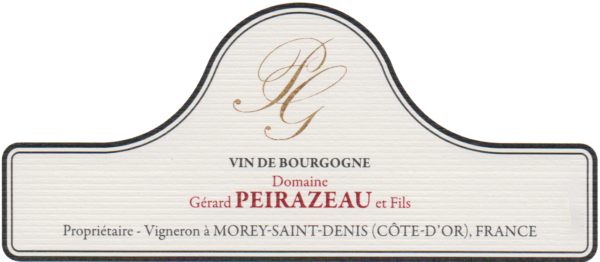
The Estate
Jules Groffier (1898-1974) acquired the first vineyard holdings of the domaine, which were later divided between his children: Robert Groffier and Bernadette Groffier. Bernadette married into the Peirazeau family and established “Domaine Peirazeau-Groffier.” Laurent Peirazeau, grandson of Bernadette and son of Gérard, decided to expand the family’s production from the 2019 vintage onward under the label “Gérard Peirazeau & Fils”.
Laurent, along with his partner Sophie Charlopin, who comes from a prominent wine family herself, manages a 3.65-hectare vineyard spread across 3 villages, including Morey St Denis, Chambolle-Musigny, and Gevrey-Chambertin. Although the vineyard is relatively small, it boasts exceptional terroirs and plot locations. The domain produces 13 appellations, 5 of which are among the most celebrated Grand Crus, including Chambertin Clos de Bèze, Charmes Chambertin, Clos de la Roche, Clos Saint-Denis, and Bonnes Mares. The majority of the vineyards consist of old vines, with an average age of 60 years.
The domaine practices sustainable cultivation using organic or biocontrol products, but is not certified. Plowing is limited, and weeding is rare.
In the cellar, Peirazeau does not use any added products; only native yeasts are used for fermentation. The red wines, except Coteaux Bourguignons and Bourgogne Pinot Noir, are all aged in oak barrels.

Coteaux Bourguignons Pinot Noir
Appellation: Coteaux Bourguignons
Grape Variety: Pinot Noir
Viticulture: The vineyard is cultivated using sustainable methods. Peirazeau uses organic products as much as possible and no pesticides. He shows respect for the subsoil with rigorous mechanical work by limiting passages in order to avoid compaction as much as possible.
Vinification: The harvest is entirely destemmed, to avoid excess tannins. In the cellar, Peirazeau has a minimal-intervention approach; he uses only indigenous yeasts and no added substances. The grapes are macerated in stainless steel tanks for 2-4 weeks with gentle manual pumping-over and punching-down for soft extraction.
Aging: In stainless steel tank.
Tasting Notes: Aromas of raspberries, cherries, and black pepper delight the palate. The tannins and acidity are well balanced, making it easy to drink.
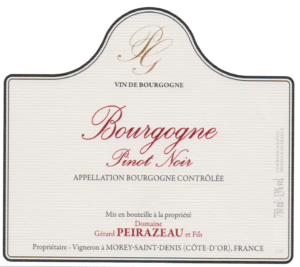
Bourgogne Pinot Noir
Vineyard Plot: The original plot was classified as a village appellation, but due to a revision of the land use plan the plot was downgraded.
Grape Variety: Pinot Noir
Viticulture: The vineyard is cultivated using sustainable methods. Peirazeau uses organic products as much as possible and no pesticides. He shows respect for the subsoil with rigorous mechanical work by limiting passages in order to avoid compaction as much as possible.
Vinification: The harvest is entirely destemmed, to avoid excess tannins. In the cellar, Peirazeau has a minimal-intervention approach; he uses only indigenous yeasts and no added substances. The grapes are macerated in stainless steel tanks for 2-4 weeks with gentle manual pumping-over and punching-down for soft extraction.
Aging: In stainless steel tank.
Tasting Notes: Classic. The Bourgogne Pinot Noir is marked by its vegetal nose. During its vinification, extractions are limited to guarantee freshness, roundness, and suppleness.
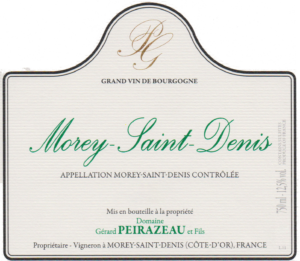
Morey-Saint-Denis Blanc
Grape Variety: Chardonnay
Viticulture: The vineyard is cultivated using sustainable methods. Peirazeau uses organic products as much as possible and no pesticides. He shows respect for the subsoil with rigorous mechanical work by limiting passages in order to avoid compaction as much as possible.
Vinification: The harvest is entirely destemmed, to avoid excess tannins. In the cellar, Peirazeau has a minimal-intervention approach; he uses only indigenous yeasts and no added substances. The grapes are macerated in stainless steel tanks for 2-4 weeks with gentle manual pumping-over and punching-down for soft extraction.
Aging: In oak barrels (around 30% new oak on average) for about 18 months, no racking. Light filtration before bottling.
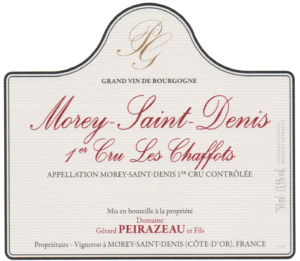
Morey-Saint-Denis 1er Cru Les Chaffots
Vineyard Plot: The plot is located above Clos Saint-Denis with very stony soil and a pronounced slope.
Grape Variety: Pinot Noir
Viticulture: The vineyard is cultivated using sustainable methods. Peirazeau uses organic products as much as possible and no pesticides. He shows respect for the subsoil with rigorous mechanical work by limiting passages in order to avoid compaction as much as possible.
Vinification: The harvest is entirely destemmed, to avoid excess tannins. In the cellar, Peirazeau has a minimal-intervention approach; he uses only indigenous yeasts and no added substances. The grapes are macerated in stainless steel tanks for 2-4 weeks with gentle manual pumping-over and punching-down for soft extraction.
Aging: In oak barrels (around 30% new oak on average) for about 18 months, no racking. Light filtration before bottling.
Tasting Notes: The feminine Morey-Saint-Denis les Chaffots is similar in style to Chambolle-Musigny. Velvety, fatty, supple, and airy are its characteristics.
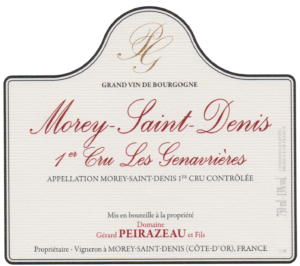
Morey-Saint-Denis 1er Cru Les Genavriéres
Vineyard Plot: Situated above Clos de la Roche and very close to Chambertin.
Grape Variety: Pinot Noir
Viticulture: The vineyard is cultivated using sustainable methods. Peirazeau uses organic products as much as possible and no pesticides. He shows respect for the subsoil with rigorous mechanical work by limiting passages in order to avoid compaction as much as possible.
Vinification: The harvest is entirely destemmed, to avoid excess tannins. In the cellar, Peirazeau has a minimal-intervention approach; he uses only indigenous yeasts and no added substances. The grapes are macerated in stainless steel tanks for 2-4 weeks with gentle manual pumping-over and punching-down for soft extraction.
Aging: In oak barrels (around 30% new oak on average) for about 18 months, no racking. Light filtration before bottling.
Tasting Notes: This Morey-Saint-Denis 1er Cru Les Genavrières evokes aromas of black cherry and cooked plum with spicy and lively touches. The palate is silky, tasty and lively. Its finish is powerful and elegant.
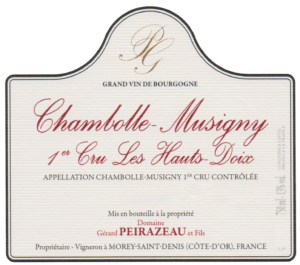
Chambolle-Musigny 1er Cru Les Hauts-Doix
Vineyard Plot: Situated between Les Charmes & Les Amoureuses.
Soil: Stony soil and a marl subsoil
Grape Variety: Pinot Noir
Average Age of the Vines: 70 years old for half of the vines, and 100 years old for the other half.
Viticulture: The vineyard is cultivated using sustainable methods. Peirazeau uses organic products as much as possible and no pesticides. He shows respect for the subsoil with rigorous mechanical work by limiting passages in order to avoid compaction as much as possible.
Vinification: The harvest is entirely destemmed, to avoid excess tannins. In the cellar, Peirazeau has a minimal-intervention approach; he uses only indigenous yeasts and no added substances. The grapes are macerated in stainless steel tanks for 2-4 weeks with gentle manual pumping-over and punching-down for soft extraction.
Aging: In oak barrels (around 30% new oak on average) for about 18 months, no racking. Light filtration before bottling.
Tasting Notes: The soil brings elegance and power controlled by a good roundness.
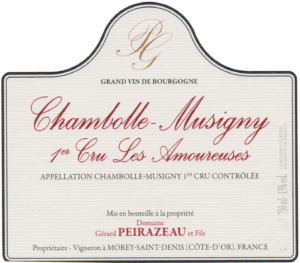
Chambolle-Musigny 1er Cru Les Amoureuses
Vineyard Plot: 0.21-hectare holding. Often considered as Grand Cru.
Grape Variety: Pinot Noir
Average Age of the Vines: Up to 80 years old.
Viticulture: The vineyard is cultivated using sustainable methods. Peirazeau uses organic products as much as possible and no pesticides. He shows respect for the subsoil with rigorous mechanical work by limiting passages in order to avoid compaction as much as possible.
Vinification: The harvest is entirely destemmed, to avoid excess tannins. In the cellar, Peirazeau has a minimal-intervention approach; he uses only indigenous yeasts and no added substances. The grapes are macerated in stainless steel tanks for 2-4 weeks with gentle manual pumping-over and punching-down for soft extraction.
Aging: In oak barrels (around 30% new oak on average) for about 18 months, no racking. Light filtration before bottling.
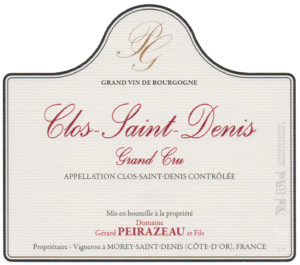
Clos Saint-Denis Grand Cru
Soil: Clay limestone and marl.
Grape Variety: Pinot Noir
Viticulture: The vineyard is cultivated using sustainable methods. Peirazeau uses organic products as much as possible and no pesticides. He shows respect for the subsoil with rigorous mechanical work by limiting passages in order to avoid compaction as much as possible.
Vinification: The harvest is entirely destemmed, to avoid excess tannins. In the cellar, Peirazeau has a minimal-intervention approach; he uses only indigenous yeasts and no added substances. The grapes are macerated in stainless steel tanks for 2-4 weeks with gentle manual pumping-over and punching-down for soft extraction.
Aging: In oak barrels (around 30% new oak on average) for about 18 months, no racking. Light filtration before bottling.
Tasting Notes: Voluptuous and gorgeous fragrance. This wine is open, elegant, and the height of sophistication.
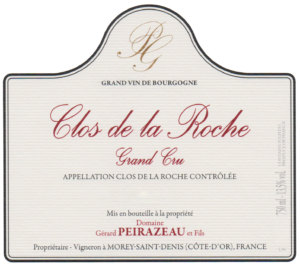
Clos de la Roche Grand Cru
Vineyard Plot: 0.40-hectare holding.
Grape Variety: Pinot Noir
Viticulture: The vineyard is cultivated using sustainable methods. Peirazeau uses organic products as much as possible and no pesticides. He shows respect for the subsoil with rigorous mechanical work by limiting passages in order to avoid compaction as much as possible.
Harvest: The vines are old, and the grapes are therefore millerandé. They are harvested very ripe while retaining their acidity, guaranteeing a high quality balance.
Vinification: The harvest is entirely destemmed, to avoid excess tannins. In the cellar, Peirazeau has a minimal-intervention approach; he uses only indigenous yeasts and no added substances. The grapes are macerated in stainless steel tanks for 2-4 weeks with gentle manual pumping-over and punching-down for soft extraction.
Aging: In oak barrels (around 30% new oak on average) for about 18 months, no racking. Light filtration before bottling.
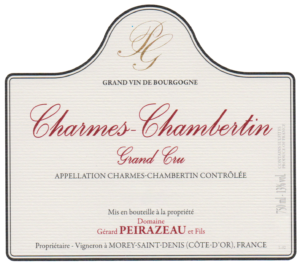
Charmes-Chambertin Grand Cru
Vineyard Plot: 0.22-hectare holding.
Soil: Limestone, with a subsoil that contains a layer of thick marl.
Grape Variety: Pinot Noir
Average Age of the Vines: Up to 80 years old.
Viticulture: The vineyard is cultivated using sustainable methods. Peirazeau uses organic products as much as possible and no pesticides. He shows respect for the subsoil with rigorous mechanical work by limiting passages in order to avoid compaction as much as possible.
Vinification: The harvest is entirely destemmed, to avoid excess tannins. In the cellar, Peirazeau has a minimal-intervention approach; he uses only indigenous yeasts and no added substances. The grapes are macerated in stainless steel tanks for 2-4 weeks with gentle manual pumping-over and punching-down for soft extraction.
Aging: In oak barrels (around 30% new oak on average) for about 18 months, no racking. Light filtration before bottling.
Tasting Notes: The soil is gives vigor to this wine which can be described as virile, but also a persistence of roundness.
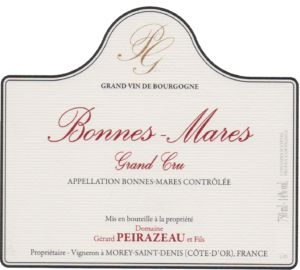
Bonnes Mares Grand Cru
Vineyard Plot: Bonnes-Mares straddles Morey-Saint-Denis and Chambolle-Musigny.
Grape Variety: Pinot Noir
Viticulture: The vineyard is cultivated using sustainable methods. Peirazeau uses organic products as much as possible and no pesticides. He shows respect for the subsoil with rigorous mechanical work by limiting passages in order to avoid compaction as much as possible.
Vinification: The harvest is entirely destemmed, to avoid excess tannins. In the cellar, Peirazeau has a minimal-intervention approach; he uses only indigenous yeasts and no added substances. The grapes are macerated in stainless steel tanks for 2-4 weeks with gentle manual pumping-over and punching-down for soft extraction.
Aging: In oak barrels (around 30% new oak on average) for about 18 months, no racking. Light filtration before bottling.
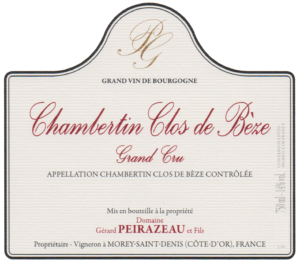
Chambertin-Clos de Bèze Grand Cru
Grape Variety: Pinot Noir
Average Age of the Vines: Up to 80 years old.
Viticulture: The vineyard is cultivated using sustainable methods. Peirazeau uses organic products as much as possible and no pesticides. He shows respect for the subsoil with rigorous mechanical work by limiting passages in order to avoid compaction as much as possible.
Vinification: The harvest is entirely destemmed, to avoid excess tannins. In the cellar, Peirazeau has a minimal-intervention approach; he uses only indigenous yeasts and no added substances. The grapes are macerated in stainless steel tanks for 2-4 weeks with gentle manual pumping-over and punching-down for soft extraction.
Aging: In oak barrels (around 30% new oak on average) for about 18 months, no racking. Light filtration before bottling.


